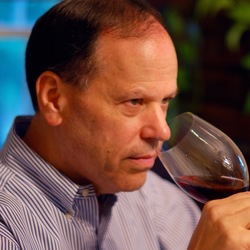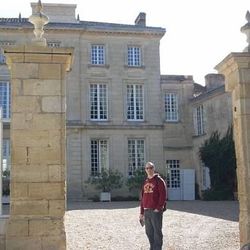Amiral De Beychevelle
Château Beaumont
Cru Bourgeois Haut-Médoc Supérieur Red Bordeaux Blend 2022
2022 vintage. This large estate is co-owned by Castel and Suntory (the group also owns Beychevelle), and this 2022 represents great value for money. 65% Cabernet Sauvignon, 30% Merlot, and 5% Petit Verdot. Compared to the Castel-owned Barreyres tasted alongside, Beaumont features a more black fruit personality,with more concentration and complexity,for only 1 euro more. Terrific value. — 9 months ago
Le Haut Medoc de Branaire-Ducru
Haut-Médoc Red Bordeaux Blend 2010
Once part of the Beychevelle estate, this is the 2nd wine of Chateau Branaire Ducru. The grape varieties are typical Bordeaux, with Cabernet Franc, Cabernet Sauvignon, Merlot and Petit Verdot. A medium bodied wine, with plum, blackberry and cassis. The fruit is very present, with soft tannines. After 10 years in the bottle still young, but soft, and years ahead of it still. Surprisingly good quality for about 17-18 Eur. Formidable! — 5 years ago
Château Beychevelle
Barton & Guestier Red Bordeaux Blend 2000
Wonderful meal with sibling and dear friend! Delicious wine and memorable night. — 7 years ago
Château Branaire (Duluc-Ducru)
St. Julien- Beychevelle Red Bordeaux Blend 2021
Blend of Cabernet Sauvignon, Merlot, Petit Verdot and a splash of Cabernet Franc, deep Ruby with aromas of dark fruits, floral spice and smoky cedar notes, aged 12 months in 60% new barrels. On the palate flavors of fresh blackberry, plum and black cherry with cacao, tobacco, licorice and smoky spice. Fine grainy tannins, well balanced on long finish, ending with fruit, cedar, smoke and earthy mineral character. Very nice, but needs a few more years of bottle age to really enjoy! — 25 days ago
Château Talbot
Saint-Julien Cabernet Sauvignon Blend 1986
1986 vintage. 5 bottles tasted for a 1986 vintage BDX dinner @ Mister A's-San Diego. This was up against other 1986's Pichon-Lalande, Beychevelle, Gruaud-Larose, Montrose and Cos. Double decanted and tasted over 5 hours. Respectable sed. Effin pop and pour now. Right right now. The clear winner. So good with balance and enough fruit without having to reach or rationalize. If you're not able to access for 7-10 years, you should be okay. Delicious. 3.14.24. — 2 years ago
Château Léoville Poyferré
Saint Julien Red Bordeaux Blend 2016
Drank 1/18/19 at the Union des Grands Crus de Bordeaux event in Miami. All wines from the 2016 Vintage.
Tasting pour, no formal notes taken. Most of these wines are very tight, and will require 5-15 years to really come together. Many will likely improve a few points with time.
This was tied with the Beychevelle for my favorite St Julien of the night. Complex dark fruit with big tannins, showing better than the Leoville Barton at this stage. — 7 years ago

Amiral de Beychevelle
Saint-Julien Red Bordeaux Blend 2020
Dark ruby in color with a wide reddish rim.
Soft nose of red and black fruits with light wood, spices, coffee, earth, dark chocolates, tobacco leaf and black pepper.
Medium plus in body with medium acidity.
Dry on the palate with blueberries, plums, cooked cherries, dark chocolates, light oak, licorice, spices and light herbs.
Long finish with fine grained tannins and tangy cherries.
This is a very tasty 5 year old second wine from Beychevelle in Saint Julien. Elegant and spicy with lots of chocolate notes.
Showing good structure, and a good quality wine. Balanced, complex and easy drinking.
Will continue to age nicely in the next 5 to 7 years. Would be nice to revisit it in 3 years and see how it evolved.
A blend of 54% Cabernet Sauvignon, 43% Merlot and 3% Cabernet Franc. Aged for 12 months in (30% new) French oak barrels.
13.5% alcohol by volume.
90 points.
$45. — 6 months ago
Château Beaumont
Cru Bourgeois Haut-Médoc Red Bordeaux Blend 2015
2015 vintage. This estate is owned these days by Grands Millésimes de France (also owner of Beychevelle), 50/50 owned by the big French Castel group and the Japanese Suntory. A blend of 50% Cabernet Sauvignon, 47% Merlot and 3% Petit Verdot. Flirting with overripeness, but still with just enough acidity to keep the balance, this is a seductive crowdpleaser that lacks a bit of complexity. Abv. 14%. — 4 years ago
Château Poujeaux
Moulis en Médoc Red Bordeaux Blend 2007
First, let me say the 07 Bordeaux vintage was largely frowned upon by professional critics. When I tasted it upon release, I had some doubts. However, I have said many times, in all difficult vintages anywhere, there are still producers that made good wine. Especially, if you give them time to evolve in bottle. This 07 has blossomed with 10 years in bottle and an absolutely perfect steak wine.
The nose reveals; smoldering ambers, dry crushed rocks, limestone minerals, ripe blackberries, black cherries, black raspberries, baked strawberries, black plum, floral blueberries, dark fruit liqueur, leather, cedar to saddle-wood, dark rich soils, stones, anise, graphite, old cigar with ash, hints of mushroom, steeped tea, fresh & withering red & dark floral bouquet.
The body is beautiful with; rich, round, velvety, smooth, tarry tannins. This 07 Poujeaux is in top form with plenty of life left ahead...another 7-10years easily. The structure, tension, length and balance are nicely knitted together. It glides effortlessly over the palate. A combination of dark currants & cassis. Ripe blackberries, black cherries, black raspberries, bright cherries, baked strawberries, black plum, floral blueberries, dark fruit liqueur, dark chocolate, mocha bar, vanilla, clove, dark spice, leather, cedar to saddle-wood, dark rich soils, stones, smoldering ambers, dry crushed rocks, dry clay, limestone minerals, dry brush, anise, graphite, old cigar with ash, touch of pepper, hints of mushroom, steeped tea, beautifully, fragrant, violets, lavender, fresh & withering red & dark floral bouquet. The acidity is nicely balanced in the wine. The finish without the steak shows dusty, grainy tannins, good balance in fruit & earth, elegant, ripe fruit and persistent on the palate.
Photos of, the unassuming Chateau Poujeaux by Bordeaux standards, the rootstock & soil structure of the Poujeaux terroir, Cellar with concrete tanks & large oak vats and a wide shot of the Estate.
Producer history and notes...Chateau Poujeaux’s history can be traced back to the 16th Century. At that time, the owner of Chateau Latour, Gaston De L’Isle, owned the estate. Over the centuries, Chateau Poujeaux, like numerous Bordeaux estates has been the property of a multitude of owners.
In fact, the owner of Chateau Beychevelle Marquis François Etienne de Brassier was one of owners. Over the centuries, Chateau Poujeaux was bought, sold, split up and divided. It was not until 1921, when the Theil family became the owners of the property that all the previously divided sections were brought back together again.
The modern era for Chateau Poujeaux began more recently. It started in 2008, when Jean Theil sold Chateau Poujeaux to the Cuvelier family, who were already owners of Clos Fourtet in St. Emilion. Once the Cuvelier family purchased, Mathieu Cuvelier took charge and things changed for the better.
The winemaking facilities were modernized and the farming technique used in the vineyards of Chateau Poujeaux were also changed.
They reduced yields and began picking later, giving them riper fruit. They also moved to an organic vineyard management approach and are looking at biodynamic farming as well. All of this work in the vineyards have helped push the wine quality of the estate. You only need to open and taste some their newer vintages. You’ll notice the improvement in fruit quality and the winemaking practices.
The 68 hectare Moulis vineyard of Chateau Poujeaux is planted to 50% Cabernet Sauvignon, 40% Merlot, 5% Cabernet Franc and 5% Petit Verdot. The terroir is gravel based soils, typical of the area as show in the above photo. The average age of the vines is close to 35 years, although some vines are older.
The debut vintage under the Cuvelier family was the 2008. At Chateau Poujeaux, they are practicing serious vineyard management with the help of Stéphane Derenoncourt, who works with numerous Bordeaux Winemakers on both banks, including the Cuvelier’s property in St. Emilion, Clos Fourtet.
Chateau Poujeaux, fruit is whole berry fermented in a combination of small stainless steel vats, oak barrels and cement tanks with a 25-day cuvaison. Chateau Poujeaux is aged in about 40% new, French oak barrels for an average of 12 months. On average, Chateau Poujeaux produces close to 25,000 cases per year. — 7 years ago









Sipping Fine Wine
Blend of 49% Merlot, 46% Cabernet Sauvignon, 3% Petit Verdot and 2% Cabernet Franc, deep Ruby red color with aromas of dark fruits, graphite and earthy herbs. On the palate flavors of blackberry, currants, black cherry, tobacco and leafy herbs. Fine polished tannins, long finish ending with fruit, tobacco, spice and earthy mineral notes. Just starting to drink now! — 17 days ago